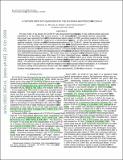A Further Drop Into Quiescence By The Eclipsing Neutron Star 4U 2129+47
Author(s)
Lin, Jinrong; Nowak, Michael A.; Chakrabarty, Deepto
DownloadChakrabarty_A further.pdf (251.1Kb)
OPEN_ACCESS_POLICY
Open Access Policy
Creative Commons Attribution-Noncommercial-Share Alike
Terms of use
Metadata
Show full item recordAbstract
The low-mass X-ray binary 4U 2129+47 was discovered during a previous X-ray outburst phase and was classified as an accretion disk corona source. A 1% delay between two mid-eclipse epochs measured ~22 days apart was reported from two XMM-Newton observations taken in 2005, providing support to the previous suggestion that 4U 2129+47 might be in a hierarchical triple system. In this work, we present timing and spectral analysis of three recent XMM-Newton observations of 4U 2129+47, carried out between 2007 November and 2008 January. We found that except for the two 2005 XMM-Newton observations, all other observations are consistent with a linear ephemeris with a constant period of 18 857.63 s; however, we confirm the time delay reported for the two 2005 XMM-Newton observations. Compared to a Chandra observation taken in 2000, these new observations also confirm the disappearance of the sinusoidal modulation of the light curve as reported from two 2005 XMM-Newton observations. We further show that, compared to the Chandra observation, all of the XMM-Newton observations have 40% lower 0.5-2 keV absorbed fluxes, and the most recent XMM-Newton observations have a combined 2-6 keV flux that is nearly 80% lower. Taken as a whole, the timing results support the hypothesis that the system is in a hierarchical triple system (with a third body period of at least 175 days). The spectral results raise the question of whether the drop in soft X-ray flux is solely attributable to the loss of the hard X-ray tail (which might be related to the loss of sinusoidal orbital modulation), or is indicative of further cooling of the quiescent neutron star after cessation of residual, low-level accretion.
Date issued
2009-11Department
Massachusetts Institute of Technology. Department of Physics; MIT Kavli Institute for Astrophysics and Space ResearchJournal
Astrophysical Journal
Publisher
IOP Publishing
Citation
Lin, Jinrong, Michael A. Nowak, and Deepto Chakrabarty. “A Further Drop Into Quiescence By The Eclipsing Neutron Star 4U 2129+47.” The Astrophysical Journal 706.2 (2009): 1069–1077.
Version: Author's final manuscript
ISSN
0004-637X
1538-4357